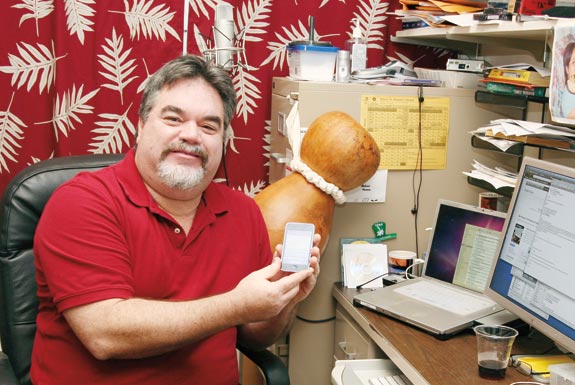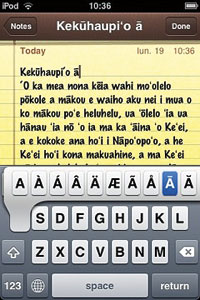Promoting Hawaiian ʻŌlelo in a Digital World
April 21st, 2010 | by Kymber-Lee Char | Published in April 2010, Features | 6 Comments

Huli iā Google. Google Search.
In the “Interface Language” menu under “Settings,” tucked between Hausa and Hebrew, Hawaiian appears on a list of more than 125 interface languages now available on Google.
Touch and hold your finger over any vowel for a second or two on an iPhone 3G S, and up pops a list of available diacritic characters.
Traditional Hawaiian language has been introduced to 21st century technologies, thanks in large part to the work of the University of Hawaiʻi at Hilo’s Ka Haka ʻUla O Keʻelikōlani College of Hawaiian Language and its Hale Kuamoʻo Hawaiian Language Center.
Established in 1989 by the Hawaiʻi State Legislature, Hale Kuamoʻo was the only state-sanctioned Hawaiian language center in Hawaiʻi and the primary source of translated and original Hawaiian language course work and curriculum, says Assistant Professor Keola Donaghy.
Learn how to use iPhone and Google in Hawaiian.
One of its early projects was the standardization of custom Hawaiian fonts in 1992. Being able to display and print Hawaiian characters was a start, but the fonts were not working together. Although Hawaiian font sets were developed using various keystroke combinations, they used different keystroke sequences for generating the Hawaiian characters and most were not compatible with standard spell checkers.
Several months of experimentation led to the establishment of Hale Kuamoʻo’s HI Font Standard, which addressed these problems.
The next challenge was exploring various options that would allow communication electronically via a computer Bulletin Board System, or BBS, the primary means of creating an online community before the World Wide Web. Donaghy has worked with the Unicode Consortium and web browser developer Netscape Communications.
“I’ve been communicating with folks at Apple for about 15 years,” he says. In 1994, Apple donated computers and offered support to the staff at Hale Kuamoʻo. The computers were used to develop Leokī (“powerful voice”), the first intranet telecommunications system implemented in an indigenous language, and Kualono, one of the first completely bilingual websites on the Internet.
Donaghy makes suggestions, waits, and then celebrates when new developments are announced. Case in point—Apple released a new Macintosh operating system in 2002, code-named Jaguar, that included a Hawaiian keyboard layout in the operating system and fonts containing diacritical marks used in the Hawaiian language.
That was a huge accomplishment for supporters of the language, Donaghy says. No longer did they need to install keyboards and depend on customized fonts and hacks to type the characters.
Seven years later, a new Apple iPhone appeared that allows users to type the ʻokina (a glottal stop) and kahakō (a macron over vowels in the Hawaiian language). The diacritical marks are essential for text messaging, emailing and web surfing in Hawaiian.
The iPhone’s operating system also has the option to display the days of the week, month and other text in Hawaiian. While the feature is included on every iPhone 3G S, an update can be installed on older iPhones and iPod Touch devices.
Next came a Google search in Hawaiian. By simply selecting Hawaiian as their language preference on Google, users can now perform searches without additional software.
“Google is the most heavily used search engine on the internet. From a practical and a symbolic standpoint, this interface puts Hawaiian on par with the many other languages that Google supports,” says Director of Ka Haka ʻUla O Keʻelikōlani Kalena Silva.
Why are the diacritical language marks so important? Without it, the pronunciation and meaning of some Hawaiian words would be tough to decipher. For instance, the word “pau” has different meanings depending on placement of diacritical marks—pau means finished; paʻu is ink powder; paʻū means moist or damp; pāʻū is a skirt worn by women on horseback.
Development of the Hawaiian language interface for Google is part of the Google in Your Language program. The company works with advocates of minority and indigenous lanPolyguages who volunteer their time to translate search instructions into their language.
Donaghy spent more than 100 hours translating the search terms that appear on the Google page into Hawaiian (with Māori, the first Polynesian language available through Google in Your Language). It was available first on Apple’s Safari web browser and quickly expanded to others. No Native American languages are available at this time.
Donaghy hopes these initiatives are just another step toward giving Hawaiian the same status as English and other European and Asian languages—relevant today, not just a part of history. It is important to preserve the Hawaiian language, he says, because “once the language is lost, the culture is lost.”
He continues: “Our ultimate goal is to have technology support so ubiquitous that people can take for granted the fact that they can simply type in Hawaiian when they buy a new computer, without installing any special software. We’re still not where we want to be, but we have made great progress, and we’re in it for the long haul.”
What’s next? Maybe Facebook in Hawaiian?
The possibilities are countless. But count on Donaghy to pursue anything that strengthens the ability for Hawaiian speakers to use their language with emerging technologies.
ʻO ka ʻōlelo ke kaʻā o ka mauli; language is the fiber that binds us to our cultural identity.
Hawaiian on the iPhone

For iPhone 3GS; upgrades available for previous models and iPod Touch.
To type a vowel with a kahakō (macron) over it—
- Touch and hold your finger on the vowel for a second or two to bring up a pop-up list with several diacritic characters.
- Drag your finger over the desired vowel-macron, then lift your finger.
To type the ʻokina (glottal stop):
- Toggle the keyboard to display number and punctuation marks by pressing the “123” key. Select the apostrophe key, hold it down for a second or two to bring up a pop-up list showing variant characters.
- Drag your finger over the far left (ʻokina) character, then lift your finger.
Google in Hawaiian
To set commands and navigational text in Hawaiian (available on many web browsers)—
- Go to the Google homepage.
- Click on “Language Tools” to the right of the search field.
- Scroll to “Use the Google Interface in Your Language” and select Hawaiian.
You can now kele, or navigate, the internet in Hawaiian. (Search results and web pages found by Google are not translated.)
To return to English, click on “Google.com in English.”
Tags: Hawaiian, Ka Haka Ula O Keelikolani College of Hawaiian Language, UH Hilo, Vol. 35 No. 1

April 28th, 2010at 7:12 am(#)
Mahalo nui kēia hoʻolaha no ka hana maikaʻi a Keola Donaghy. ʻO ka hua o kāna mau hana he hoʻōla a hoʻolaha ia i ka ʻōlelo makuahine o Hawaiʻi nei. Hoʻomaikaʻi.
April 30th, 2010at 7:00 pm(#)
[...] Hawaiian ʻŌlelo in a Digital World [...]
May 21st, 2010at 3:57 pm(#)
How are you preserving macron characters in WordPress. If I enter them with &# codes, they get wiped out when someone saves the post while in the visual editor.
May 24th, 2010at 9:12 am(#)
Hi Karen,
Our solution is to only use the HTML editor in WordPress, because the visual one does have that problem. Not an ideal fix but the best we’ve found so far.
Hope this helps,
Jeela
August 25th, 2011at 7:53 pm(#)
I can’t get the date time and all that to change into Hawaiian, I actually don’t see an option for Hawaiian language anywhere. Help please!
September 10th, 2011at 6:32 pm(#)
E Kuʻu Palala ē, ke kenelala o ka ʻenehana, ʻo ʻoe nō kā hoʻi i hoʻoHawaiʻi mau mai ai i nā mea ʻenehana like ʻole no kākou o ka honua nei!
Mahalo palenaʻole!
Akah a loaʻa maila kahi kelepona e hiki ai ke kikokiko i nā hua Hawaiʻi.
Me ka haʻahaʻa a me ka ʻoiaʻiʻo,
na Liko Puha